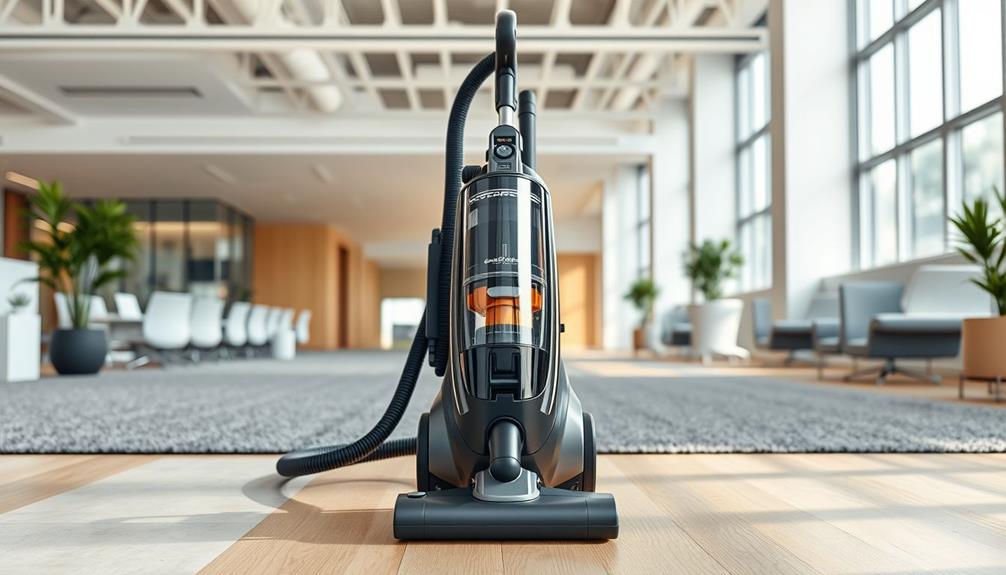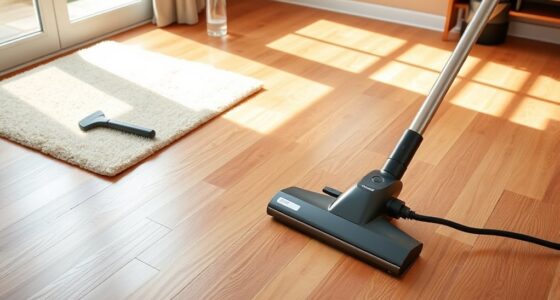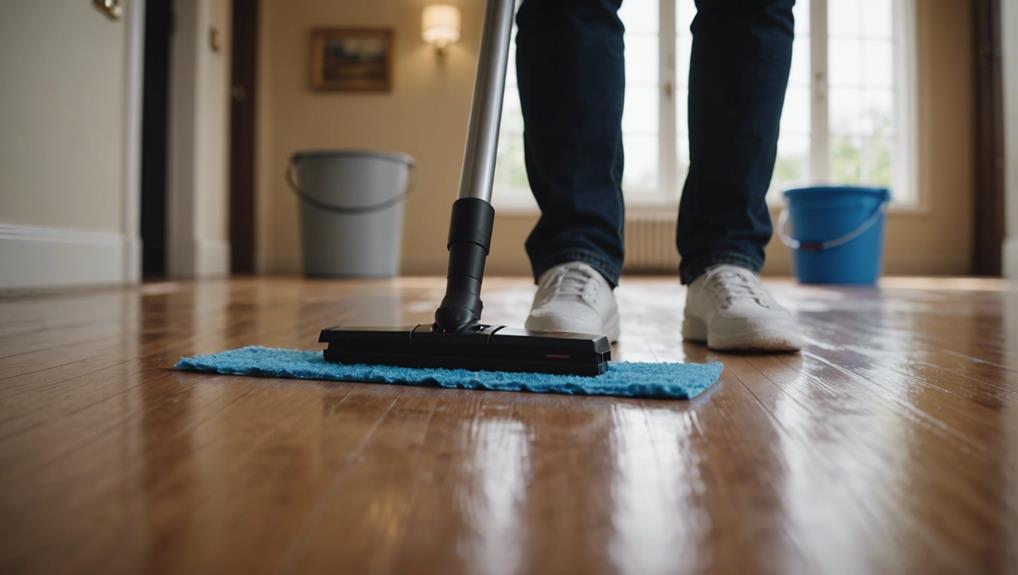Understanding vacuum cleaner warranties is crucial in order to protect your investment. Most warranties typically cover manufacturing defects such as faulty motors and electrical issues, and usually last from one to five years. However, they often do not cover normal wear and tear, misuse, or damages from unauthorized repairs. It is important to be aware of the specific coverage for your vacuum model, as it can vary greatly. It is also important to register your warranty and keep documentation for easy claims processing. By understanding these details, you can ensure that you are covered and avoid unexpected expenses. There is more to learn that could potentially save you from headaches in the future.
Key Takeaways
- Vacuum warranties typically last from one to five years, covering manufacturing defects but excluding wear and tear and misuse.
- Commonly covered issues include mechanical parts, electrical problems, and performance defects, while misuse and unauthorized repairs void the warranty.
- Warranties generally apply to residential use; commercial usage or operation outside designated regions may disqualify claims.
- Registering the warranty and keeping documentation like purchase receipts are essential for smooth claims processing.
- Extended warranty options can provide additional protection against mechanical failures and may save on repair costs.
What Is a Vacuum Warranty?
A vacuum warranty is fundamentally a promise from the manufacturer that they'll cover repairs or replacements for defects in materials and workmanship. Typically, these warranties last from one to five years, depending on the brand and model of your vacuum cleaner.
Most warranties cover parts and labor for manufacturing defects but often exclude issues like normal wear and tear or damages from misuse. For instance, vacuums designed for specific surfaces, like those for luxury vinyl plank (LVP) floors, might've unique warranty terms reflecting their specialized features.
You should know that common problems addressed under these warranties include defective motors, electrical malfunctions, and performance issues such as loss of suction.
It's also important to remember that warranties are generally non-transferable, meaning they apply only to the original purchaser. Keeping your purchase documentation is essential, as it can save you from potential headaches down the line.
Understanding the specific terms and conditions of your vacuum warranty is significant. This knowledge helps you avoid any misunderstandings regarding what's covered and how to properly file a claim if needed.
Coverage of Vacuum Warranties

When you buy a vacuum cleaner, understanding what the warranty covers is vital. Most warranties protect against manufacturing defects and usually include issues like faulty motors and electrical problems.
It's important to also consider what to look for in a home cleaning service, as this knowledge can help you better understand the care your vacuum may need over time.
However, it's significant to recognize that normal wear and tear, misuse, and damages from unauthorized repairs often aren't covered.
Common Coverage Areas
Covering key aspects of vacuum cleaner performance, warranties primarily address manufacturing defects, ensuring that issues like faulty motors, belts, and electrical components can be repaired without additional costs.
For pet owners, having a vacuum with effective hair removal features, such as the self-cleaning brush roll technology found in models like the Bissell Pet Hair Eraser, can greatly impact maintenance and usability.
However, it's important to read the terms carefully, as warranties only cover specific areas. Here are common coverage areas you can expect:
- Manufacturing defects: Issues related to faulty parts directly from the factory.
- Performance problems: Loss of suction or unusual noises, given proper usage.
- Electrical issues: Failures in the motor or wiring that aren't due to misuse.
- Mechanical parts: Coverage for belts and other components that fail due to manufacturing errors.
- Extended warranties: Some brands offer extra coverage for high-end models or specific components.
Keep in mind that while these areas are generally covered, specific terms may vary by model and manufacturer.
Being aware of what's included in your warranty can save you from unexpected costs in the future. Always check the details so you know exactly what to expect, ensuring you're well-prepared should any issues arise.
Typical Exclusions Explained
While understanding what's typically covered in vacuum cleaner warranties is important, knowing the exclusions is just as critical. Many people don't realize that warranties are so important for protecting your investment, but they often come with significant limitations.
For example, normal wear and tear isn't covered, which includes parts like filters and belts that naturally degrade over time. Additionally, just as cats can show signs of distress when their environment changes, vacuum cleaners can also exhibit issues if not maintained properly, highlighting the importance of cat behavior and emotional attachment.
Misuse of your vacuum, such as using it for commercial purposes or ignoring the manufacturer's instructions, can void your warranty altogether. If you make unauthorized repairs or modifications, you can also find yourself without coverage.
Additionally, physical damage caused by external factors—like dirt, debris, or accidents—usually leads to denial of warranty claims.
Another common exclusion is geographical limitations; if you operate your vacuum outside of specified regions like the USA and Canada, you mightn't be eligible for service.
It's crucial to read the fine print so you know what to expect when something goes wrong. Being aware of these exclusions will help guarantee that your vacuum is repaired or replaced under warranty when the time comes.
Common Exclusions and Limitations

When you look at vacuum cleaner warranties, you'll find that they often exclude coverage for normal wear and tear, such as belts and filters.
Additionally, some warranties may not cover damages caused by using the vacuum on surfaces it wasn't designed for, like wet or sandy areas.
Misusing the vacuum, like using it in a commercial setting or ignoring the guidelines, can also void your warranty.
It's essential to read the fine print, as specific exclusions can vary considerably between models.
For instance, understanding the specifics of garage door openers can help you make informed decisions about warranty coverage.
Misuse and Damage Exclusions
Misunderstandings about vacuum cleaner warranties often arise from unclear exclusions related to misuse and damage.
It's essential to understand that many warranty exclusions are in place to protect manufacturers from improper use. For instance, if you use your vacuum for non-intended purposes or operate it outside the manufacturer's guidelines, you might void your warranty.
Common exclusions include:
- Damage from using the vacuum for commercial purposes
- Issues arising from modifications or unauthorized repairs
- Damage caused by external factors, like dirt or moisture
- Misuse that leads to operational failures
- Wear and tear not covered under warranty exclusions
Additionally, being aware of the importance of compliance with warranty terms can save you from unexpected expenses.
Always consult your warranty terms for specific details, as each manufacturer may have different stipulations. By adhering to proper usage guidelines, you can guarantee your vacuum cleaner remains protected under its warranty.
Ignoring these exclusions can lead to costly repairs and disappointment when you need support the most. Understanding these misuse and damage exclusions will empower you to maintain your vacuum cleaner effectively.
Wear and Tear Limitations
Understanding the limitations of wear and tear in vacuum cleaner warranties is crucial for any owner. Most warranties come with a limited warranty that excludes coverage for normal wear and tear. This means that parts like filters, belts, and brushes, which inevitably degrade over time, aren't eligible for claims.
Regular maintenance of your vacuum can help extend its lifespan and guarantee it operates efficiently, similar to the way regular maintenance improves efficiency in appliances. If you misuse your vacuum, such as using it on surfaces it wasn't designed for or neglecting the manufacturer's guidelines, you risk voiding your warranty altogether.
Additionally, if you attempt unauthorized repairs or modifications, you could also find yourself without coverage for defects. It's vital to recognize that warranties typically cater to residential use, so if you use your vacuum for commercial purposes, you're likely out of luck.
Lastly, be aware that operating your vacuum outside designated regions, such as the USA or Canada, can disqualify you from warranty claims. To protect your investment, always follow the manufacturer's instructions and use your vacuum as intended.
Familiarizing yourself with these wear and tear limitations will save you frustration and unexpected costs down the line.
Model-Specific Warranty Insights

Steering through the warranties of different vacuum cleaner models can be tricky, especially with variations in coverage. A solid understanding of content credibility and engagement is crucial when evaluating the warranty terms, as each brand has its unique terms.
It's essential to understand what you're getting when you make a purchase. Here's a quick overview of some popular models:
- Dyson: Offers up to five years of warranty on mechanical and electrical parts, excluding misuse and wear-and-tear.
- Hoover: Their standard warranty may not cover all repairs, so consider additional protection plans for full coverage.
- Miele: Impressively provides up to ten years of warranty, including lifetime filters as part of the deal.
- Bissell: Generally comes with a five-year warranty, but check specific models for varying terms.
- Shark: Typically features a one-year warranty that may vary by region, necessitating a review of specific terms.
Understanding these model-specific warranties can save you from unexpected repair costs.
Regular maintenance can also help guarantee your vacuum remains in good condition, which might extend the life of your warranty.
Importance of Understanding Terms

When it comes to vacuum cleaner warranties, knowing the terms can make all the difference in protecting your investment. Understanding these warranties is essential because they define the duration of coverage, which typically ranges from one to five years based on your vacuum model and manufacturer.
While warranties generally cover manufacturing defects, they often exclude common issues like wear-and-tear or damages from misuse and external factors, such as dirt or debris. Additionally, comprehending the financial aspects of divorce can help you manage unexpected costs that could arise if your vacuum fails outside of warranty coverage.
Many manufacturers require you to register your warranty and follow specific usage guidelines to guarantee that your claims are processed smoothly.
The fine print usually contains detailed information about the claims process, including necessary documentation like purchase receipts and serial numbers. Failing to read this fine print could leave you unaware of unique limitations or conditions that may affect your claims and consumer rights.
How to Activate Your Warranty

To activate your vacuum cleaner warranty, start by locating the serial number on your device and noting the purchase date and price. This information is vital for claims processing.
Many manufacturers encourage you to register your warranty to validate coverage and guarantee better service. It's also important to maintain a clean environment around your vacuum cleaner to prevent any issues that could affect its performance and warranty.
Here's a simple guide to help you through the process:
- Find the serial number on your vacuum cleaner.
- Keep a record of the purchase date and price.
- Gather documentation, including the purchase receipt and warranty terms.
- Visit the manufacturer's website or call customer service for warranty activation.
- Keep a digital copy of user guides and warranty information for easy access.
When you contact customer service or use the website, you'll need your serial number for warranty activation. Having all this information ready guarantees a smoother process and helps avoid any delays.
Remember, activating your warranty not only protects your investment but also opens the door to support and services during the warranty period. Stay organized, and you'll be prepared should you need to utilize your warranty in the future.
Additionally, understanding the importance of proper maintenance can contribute to the longevity of your vacuum cleaner and enhance its performance, much like how air purifiers improve indoor air quality.
Claiming Warranty Services

Once you've activated your warranty, knowing how to claim warranty services is the next step if you encounter issues with your vacuum cleaner.
Start by gathering essential documentation, like your purchase receipt and warranty information, as these are critical for verification. Then, contact the manufacturer's customer service to initiate the claim process. Be sure to provide a clear description of the issue you're facing.
Next, read the fine print of your warranty to understand any specific instructions regarding the return of defective products or parts. Following these directions carefully is essential to guarantee compliance with warranty requirements.
Keep detailed records of all communications and actions taken during the claim process; this history can be invaluable for future reference.
Extended Warranty Options

While many consumers rely on standard manufacturer warranties for their vacuum cleaners, considering extended warranty options can greatly enhance your coverage. Extended warranties, like those offered by Upsie, can protect you from mechanical failures, including issues with motors and internal parts that standard warranties often overlook.
Here are some benefits of choosing an extended warranty:
- Comprehensive Coverage: Protects against unexpected mechanical failures.
- Cost-Effective: Upsie warranties can be up to 70% cheaper than competitors.
- No Deductibles: Enjoy hassle-free claims without out-of-pocket expenses.
- Unlimited Claims: File as many claims as needed up to the purchase price.
- Peace of Mind: Avoid unexpected repair costs and guarantee a smooth repair process.
If you recently purchased your vacuum, you can buy an Upsie warranty within 60 days of the purchase.
With prices like $44.99 for a two-year warranty on a $899 Dyson vacuum, not only do you enhance your protection, but you also save money.
Investing in an extended warranty option can make all the difference in your vacuum cleaner's longevity and your overall satisfaction.
Evaluating Warranty Value and Needs

Evaluating the value of a vacuum cleaner warranty requires a careful look at your specific needs and the coverage offered. Start by comparing different warranty options for your vacuum model. For instance, brands like Miele provide up to ten years of coverage, while others, like Shark, may only offer one year.
Next, consider the potential repair costs. Some warranties, such as Upsie, can save you money—like a two-year warranty for a $899 Dyson costing only $44.99, compared to Best Buy's $129.99 for the same coverage.
It's crucial to review the fine print, too, as limitations and exclusions can affect your satisfaction. Common issues like normal wear and tear often aren't covered, which could lead to unexpected expenses.
Assess your personal usage needs; residential users might find standard warranties sufficient, whereas commercial users may need more extensive protection.
Frequently Asked Questions
What Is Not Covered by the Warranty?
When you consider what's not covered by warranties, keep in mind that normal wear and tear isn't included.
This means parts like filters or belts won't be replaced. If you misuse your vacuum, that can void the warranty, too.
Additionally, if you take your vacuum for commercial use or make unauthorized repairs, you could lose coverage.
Operating outside the USA and Canada also limits your warranty claims.
What Products Are Covered by Warranty?
When you purchase a vacuum cleaner, you'll typically find that the warranty covers manufacturing defects like motor issues, electrical faults, and belt problems.
Most brands guarantee you're protected against these defects for a specified period, which can vary greatly. Some high-end models even offer extended coverage, up to ten years.
Just remember, wear-and-tear items like filters usually aren't included, so check your warranty details to know exactly what's covered.
Are Vacuum Warranties Worth It?
Are vacuum warranties worth it? Oh, absolutely! Who wouldn't want to pay extra for the privilege of dealing with the fine print?
You'll love discovering that your vacuum's "normal wear and tear" isn't covered. But hey, if you enjoy unexpected repair costs and the thrill of comparing warranty providers, go for it!
Just remember, you might be better off saving that cash for a new vacuum instead of gambling on a warranty.
Does Shark Vacuum Have a Lifetime Warranty?
No, Shark vacuums don't have a lifetime warranty.
They typically come with a one-year warranty that covers manufacturing defects.
If you're considering a Shark vacuum, keep in mind that this warranty only applies during that period, so you'll want to handle it properly to avoid voiding it.
If you're looking for extended protection, you might want to explore additional warranty options from third-party providers.
Conclusion
Now that you've explored the ins and outs of vacuum cleaner warranties, envision this: your trusty vacuum suddenly sputters and stops. In that moment, knowing exactly what's covered could mean the difference between a costly repair and a simple fix. Don't let surprises catch you off guard! Take the time to understand your warranty fully. A little preparation now can save you frustration later, ensuring your home stays spotless without breaking the bank.









